Real Driving Emissions in Extended Driving Conditions
Abstract
:1. Introduction
- Specifications and calibration of PEMS components and signals.
- Verification of overall trip dynamics with MAW (moving average windows) and with RPA (relative positive acceleration).
- Determination of the cumulative positive elevation gain of a PEMS trip.
- Calculation of final RDE emissions.
- Data exchange and reporting requirements.
- Provisions for in-service-conformity (ISC).
2. Testing Material, Means, and Methods
2.1. Test Vehicles and Uesd Gas PEMS and PN PEMS
2.2. Gas PEMS and PN PEMS
- Horiba OBS-ONE PN measurement system (OBS-PN). This analyzer works on the condensation particles counter (CPC) principle, has an integrated sample conditioning system (double dilution and catalytic stripper ViPR, 350 °C), and it indicates the summary PN concentrations in the size range 23 to approximately 1000 nm.
- NanoMet3 from TESTO (NM3). This analyzer works on diffusion charging (DC) principle, has an integrated sample conditioning system, and it indicates the solid particle number concentration and geometric mean diameter in the size range 10–700 nm.
- Primary dilution—MD19 tunable rotating disk diluter (Matter Eng. MD19-2E).
- Secondary dilution—dilution of the primary diluted and thermally conditioned sample gas on the outlet of evaporative tube.
- Thermoconditioner (TC)—sample heating at 300 °C.
2.3. Test Procedures
3. Results
3.1. Winter/Summer Conditions
3.2. Mild/Aggressive Driving
- The mild and dynamic driving styles have clearly different parameters of the RPA and (v.a pos); both parameters are higher for aggressive driving.
- During road driving, the parameters of the RPA and (v.apos) are for each variant of vehicle and driving style quite repetitive.
- With the diesel vehicle, an excessive driving dynamic, beyond the legal acceptance, was realized.
- The driving style has an influence on the CO2-normality.
- The normality check is also passed with the dynamic driving style.
- The DPF regeneration (diesel) has an influence on the CO2-normality, which may cause the check to fail.
- The driving style has a very strong influence on CO-emissions and the results from the three tests are quite repetitive (except for highway).
- The driving style also influences strongly the NOx-emissions during cold start and city part; in case of aggressive driving in the urban part, the NOx-values scatter vary much which also explains the large differences of cumulated NOx with the “dynamic” driving.
- The “dynamic” driving requires more energy, causes higher fuel consumption, and, therefore, higher CO2-emissions.
- There is no visible effect of driving style on the PN-emissions, the absolute values in (#/km) for this GDI-vehicle, without GPF are quite high, above the legal limit of 6 × 1011 (#/km).
- The CO-emissions are very low and they are independent of the driving style.
- All other emissions of NOx, CO2, and PN are clearly increased by the dynamic driving style.
3.3. Higher Slope/Altitude
- Moderate altitude below 700 m above sea level.
- Extended altitude conditions 700–1300 m above sea level.
- Start and end points of the trip shall not differ in their altitudes more than 100 m.
- The cumulative positive gain over the entire trip shall be less than 1200 m/100 km.
- Route cir2 could be accepted for elevation check, but the increase of the CO2 emissions due to the performed altitude variation leads to a failing CO2 result (not similar to the WLTC CO2 emissions).
- Route cir3 shows that both CO2 emissions and higher altitude variation are beyond the accepted limits.
4. Conclusions
- For the gasoline vehicle, there are in winter conditions higher values of CO2 and CO in the total trip. For NOx and PN, there are no significant differences.
- For the diesel vehicle, the winter-operation increases slightly the CO2- and NOx-values. The levels of CO and PN stay unchanged.
- The DPF regeneration increases clearly (both in summer and in winter tests) CO2-, NOx-, and PN-values.
- The mild and dynamic driving styles have clearly different parameters of the RPA and (v.apos); both parameters are higher for aggressive driving.
- During road driving, the parameters of the RPA and (v.apos) are for each variant of vehicle and driving style quite repetitive.
- With the diesel vehicle, an excessive driving dynamic, beyond the legal acceptance, was realized.
- The driving style has an influence on the CO2-normality.
- The DPF regeneration (Diesel) has an influence on the CO2-normality, which may cause the check to fail.
- The driving style has reproducible effects on the emissions.
- The aggressive driving generally increases the emissions, except PN for gasoline car (w/o GPF) and CO for diesel car (DOC + DPF).
- The “dynamic” driving requires more energy, causes higher fuel consumption, and, therefore, higher CO2-emissions.
- The PN-emissions of the gasoline vehicle (GDI w/o GPF) are above, the PN-emissions of the diesel vehicle (with DPF) are below the limit value of 6 × 1011 (#/km).
- There is a higher NOx-emissions level of the diesel car.
- The emissions of CO, NOx, CO2, and PN are generally increased by higher slope/altitude.
- The sharp increases of CO and NOx in the diagrams for cir2 and cir3 can be attributed to the dynamic driving events combined with higher power demand for the slope.
- Higher slope requires more energy and causes higher CO2.
- The influence on PN is small.
Author Contributions
Funding
Acknowledgments
Conflicts of Interest
Abbreviations
| AFHB | Abgasprüfstelle FH Biel, CH |
| BFH-TI | Bern University of Applied Sciences, Engineering and Information Technology |
| CF | Conformity Factor |
| cir | test circuit |
| CLD | Chemoluminescence Detector |
| CPC | condensation particles counter |
| DC | diffusion charging |
| DI | Direct Injection |
| DOC | Diesel Oxidation Catalyst |
| DPF | Diesel Particle Filter |
| ECU | Engine Control Unit |
| EFM | Exhaust Flow Meter |
| EGR | Exhaust gases recirculation |
| EU | European Union |
| EMROAD | Data processing reference software |
| FID | Flame Ionization Detector |
| FOEN | Federal Office of Environment, CH |
| GDI | gasoline direct injection |
| GPF | Gasoline particulate filter |
| GPS | Global Positioning System |
| GTAA | Granting Type Approval Authority |
| ICE | Internal Combustion Engine |
| ISC | in-service-conformity |
| LD | Light Duty (personal car) |
| LDV | Light Duty Vehicle |
| MAW | Moving Average Window |
| MD | rotating disc minidiluter |
| NDIR | Non-Dispersive Infrared |
| NM3 | NanoMet3 |
| OBD | On Board Diagnosis |
| OBS | Horiba on board system |
| PC | passenger car |
| PEMS | Portable Emissions measurement system |
| PN | Particle Number |
| r | share of normal windows (MAW) |
| RDE | Real Driving Emission |
| ResRDE | research of RDE |
| RPA | Relative Positive Acceleration |
| SCR | Selective Catalytic Reduction |
| TC | thermo-conditioner |
| TWC | Three-way catalyst |
| V | vehicle |
| ViPR | volatile particle remover |
| WLTC | World Light-Duty Transient Cycle |
| WP | working package |
References
- Commission Regulation (EU) 2017/1151 of 1 June 2017, Supplementing Regulation (EC) No 715/2007. Available online: http://data.europa.eu/eli/reg/2017/1151/2020-01-25 (accessed on 15 October 2021).
- Schöggl, M. EU-Update Draft RDE Package 4. AVL Emission TechDay 2018, 6 April 2018. Available online: https://www.avl.com/documents/1982862/8084402/10_RDE+-+Real+Driving+Emissions+-+was+steckt+wirklich+dahinter.pdf (accessed on 15 October 2021).
- Changes to the Motor Vehicle Type-Approval System in the European Union. Policy Update ICCT-May 2018. Available online: www.theicct.org (accessed on 15 October 2021).
- PEMS Guidance Document. Available online: https://publications.jrc.ec.europa.eu/repository/handle/JRC95958 (accessed on 15 October 2021).
- 2017 PEMS Uncertainty Assessment. Available online: http://publications.jrc.ec.europa.eu/repository/bitstream/JRC109841/kjna29138enn.pdf (accessed on 15 October 2021).
- Questions and Answers on RDE. Available online: https://circabc.europa.eu/sd/a/7e0496c2-67fb-4468-9755-dfd93917d38a/Q%26A%20RDE%20vs2.pdf (accessed on 15 October 2021).
- EMROAD Tool and Exchange Sample Files. Available online: https://circabc.europa.eu/ui/group/f4243c55-615c-4b70-a4c8-1254b5eebf61/library/79a4a9b6-4003-4e02-956d-048dcef1a169 (accessed on 15 October 2021).
- European Environment Agency. EMEP/EEA Air Pollutant Emission Inventory Guidebook 2016; EEA Report. No 21/2016; European Environment Agency: Copenhagen, Denmark, 2016; Available online: https://www.eea.europa.eu//publications/emep-eea-guidebook-2016 (accessed on 29 March 2019).
- Valverde, V.; Mora, B.A.; Clairotte, M.; Pavlovic, J.; Suarez-Bertoa, R.; Giechaskiel, B.; Astorga-LLorens, C.; Fontaras, G. Emission Factors Derived from 13 Euro 6b Light-Duty Vehicles Based on Laboratory and On-Road Measurements. Atmosphere 2019, 10, 243. [Google Scholar] [CrossRef] [Green Version]
- Franco, V.; Kousoulidou, M.; Muntean, M.; Ntziachristos, L.; Hausberger, S.; Dilara, P. Road vehicle emission factors development: A review. Atmos. Environ. 2013, 70, 84–97. [Google Scholar] [CrossRef]
- Ntziachristos, L.; Gkatzoflias, D.; Kouridis, C.; Samaras, Z. COPERT: A European road transport emission inventory model. In Information Technologies in Environmental Engineering; Athanasiadis, P.A., Mitkas, A.E., Rizzoli, J., Gómez, M., Eds.; Springer: New York, NY, USA, 2009; pp. 491–504. [Google Scholar]
- Giechaskiel, B.; Gioria, R.; Carriero, M.; Lähde, T.; Forloni, F.; Perujo, A.; Martini, G.; Bissi, L.M.; Terenghi, R. Emission Factors of a Euro VI Heavy-Duty Diesel Refuse Collection Vehicle. Sustainability 2019, 11, 1067. [Google Scholar] [CrossRef] [Green Version]
- Andersson, J.; May, J.; Favre, C.; Bosteels, D.; de Vries, S.; Heaney, M.; Keenan, M.; Mansell, J. On-Road and Chassis Dynamometer Evaluations of Emissions from Two Euro 6 Diesel Vehicles. SAE Int. J. Fuels Lubr. 2014, 7, 919–934, SAE Technical Paper 2014-01-2826. [Google Scholar] [CrossRef] [Green Version]
- Bielaczyc, P.; Woodburn, J.; Szczotka, A. Exhaust Emissions of Gaseous and Solid Pollutants Measured over the NEDC, FTP-75 and WLTC Chassis Dynamometer Driving Cycles. 2019. Available online: https://www.sae.org/publications/technical-papers/content/2016-01-1008/ (accessed on 18 October 2021).
- May, J.; Bosteels, D.; Favre, C. An Assessment of Emissions from Light-Duty Vehicles using PEMS and Chassis Dynamometer Testing. SAE Int. J. Engines 2014, 7, 1326–1335. [Google Scholar] [CrossRef] [Green Version]
- Clairotte, M.; Valverde, V.; Bonnel, P.; Giechaskiel, B.; Carriero, M.; Otura, M.; Fontaras, G.; Pavlovic, J.; Martini, G.; Krasenbrink, A.; et al. Joint Research Centre, Light-Duty Vehicles Emissions Testing; Publications Office of the European Union: Luxembourg, 2018. [Google Scholar]
- Czerwinski, J.; Zimmerli, Y.; Comte, P.; Bütler, T. Experiences and Results with different PEMS. In Proceedings of the TAP Paper, International Transport and Air Pollution Conference, Lyon, France, 24–26 May 2016. [Google Scholar]
- Czerwinski, J.; Zimmerli, Y.; Comte, P.; Cachon, L.; Riccobono, F. Potentials of the portable emission measuring systems (PN PEMS) to control real driving emissions (RDE). In Proceedings of the 38 International Vienna Motor Symposium, Vienna, Austria, 27–28 April 2017; Volume 2. VDI Fortschritt-Bericht, Reihe 12, Nr. 802. [Google Scholar]
- Czerwinski, J.; Comte, P.; Zimmerli, Y.; Cachon, L.; Remmele, E.; Huber, G. Research of Emissions with Gas PEMS and PN PEMS. In Proceedings of the TAP Paper, International Transport and Air Pollution Conference, EMPA, Zürich, Switzerland, 15–16 November 2017. [Google Scholar]
- Giechaskiel, B.; Roccobono, F.; Bonnel, P. Feasibility Study on the Extension of the Real Driving Emissions (RDE) Procedure to Particle Number (PN); European Commission, Joint Research Centre: Ispra, Italy, 2015; ISBN 978-92-79-51003-8. ISSN 1831-9424. [Google Scholar] [CrossRef]
- Suarez-Bertoa, R.; Valverde, V.; Clairotte, M.; Pavlovic, J.; Giechaskiel, B.; Franco, V.; Kregar, Z.; Astorga, C. On-road emissions of passenger cars beyond the boundary conditions of the real-driving emissions test. Environ. Res. 2019, 176, 108572. [Google Scholar] [CrossRef] [PubMed]
- O’Driscoll, R.; Stettler, M.E.J.; Molden, N.; Oxley, T.; ApSimon, H.M. Real world CO2 and NOX emissions from 149 Euro 5 and 6 diesel, gasoline and hybrid passenger cars. Sci. Total Environ. 2018, 621, 282–290. [Google Scholar] [CrossRef] [PubMed]
- Luján, J.M.; Bermúdez, V.; Dolz, V.; Monsalve-Serrano, J. An assessment of the real-world driving gaseous emissions from a Euro 6 light-duty diesel vehicle using a portable emissions measurement system (PEMS). Atmos. Environ. 2018, 174, 112–121. [Google Scholar] [CrossRef]
- Bodisco, T.; Zare, A. Practicalities and Driving Dynamics of a Real Driving Emissions (RDE) Euro 6 Regulation Homologation Test. Energies 2019, 12, 2306. [Google Scholar] [CrossRef] [Green Version]
- Deppenkemper, K.; Ehrly lng, M.; Schoenen, M.; Koetter, M. Super Ultra-Low NOX Emissions under Extended RDE Conditions—Evaluation of Light-Off Strategies of Advanced Diesel Exhaust Aftertreatment Systems; SAE Technical Paper 2019-01-0742; SAE International: Detroit, MI, USA, 2019. [Google Scholar] [CrossRef]
- Bielaczyc, P.; Szczotka, A.; Woodburn, J. The effect of a low ambient temperature on the cold-start emissions and fuel consumption of passenger cars. J. Automob. Eng. 2011, 225, 1253–1264. [Google Scholar] [CrossRef]
- Dardiotis, C.; Martini, G.; Marotta, A.; Manfredi, U. Low-temperature cold-start gaseous emissions of late technology passenger cars. Appl. Energy 2013, 111, 468–478. [Google Scholar] [CrossRef]
- Suares-Bertoa, R.; Astorga, C. Impact of cold temperature on Euro 6 passenger car emissions. Environ. Pollut. 2018, 234, 318–329. [Google Scholar] [CrossRef] [PubMed]
- Merkisz, J.; Pielecha, J.; Jasiński, R. Remarks about Real Driving Emissions tests for passenger cars. Arch. Transp. 2016, 39, 51–63. [Google Scholar] [CrossRef]
- Williams, R.; Andersson, J.; Hamje, H.; Ziman, P.; Kar, K.; Fittavolini, C.; Pellegrini, L.; Gunther, G.; Oliva, F.; Van de Heijning, P. Impact of Demanding Low Temperature Urban Operation on the Real Driving Emissions Performance of Three European Diesel Passenger Cars; SAE Technical Paper 2018-01-1819; SAE International: Detroit, MI, USA, 2018. [Google Scholar] [CrossRef]
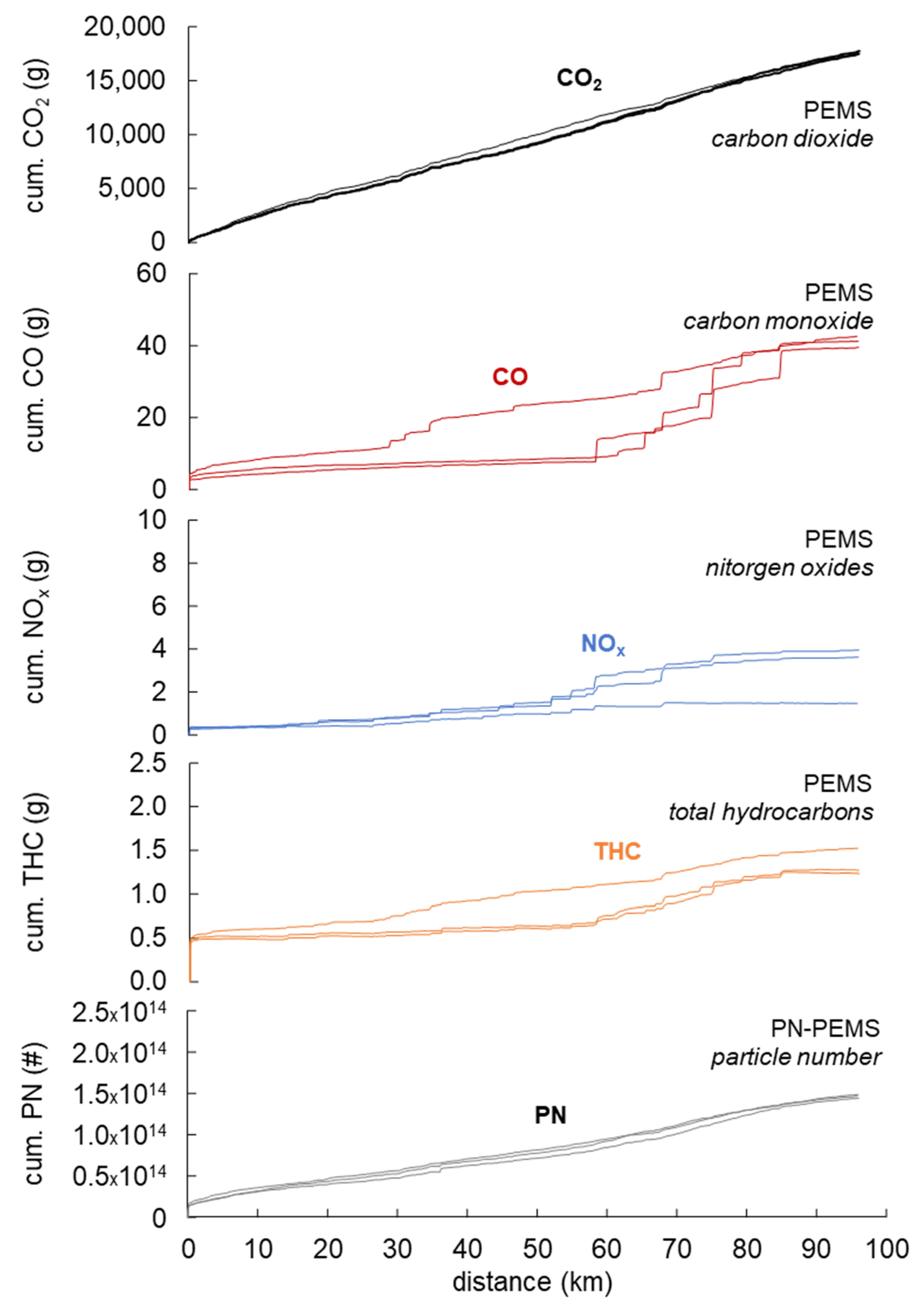

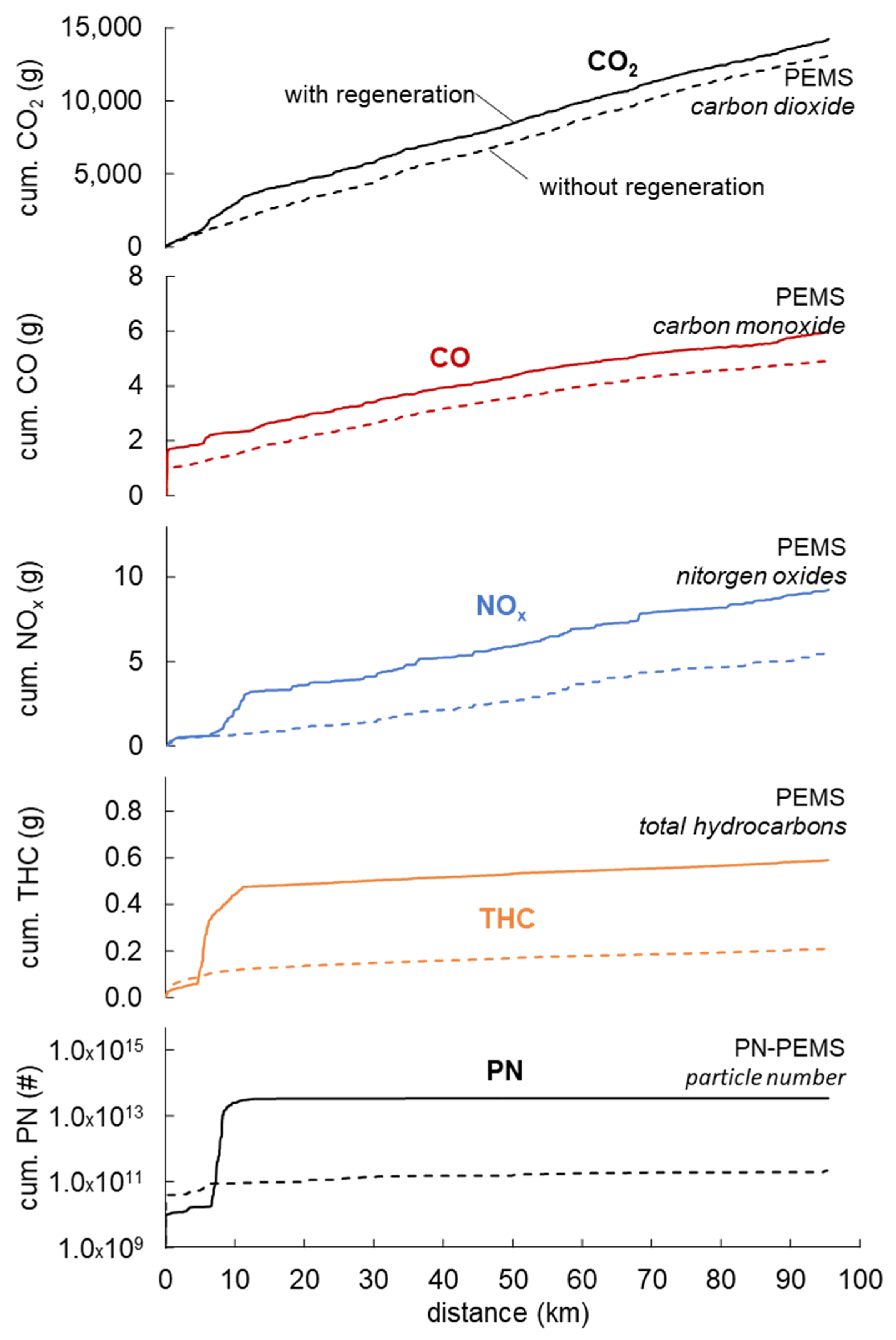


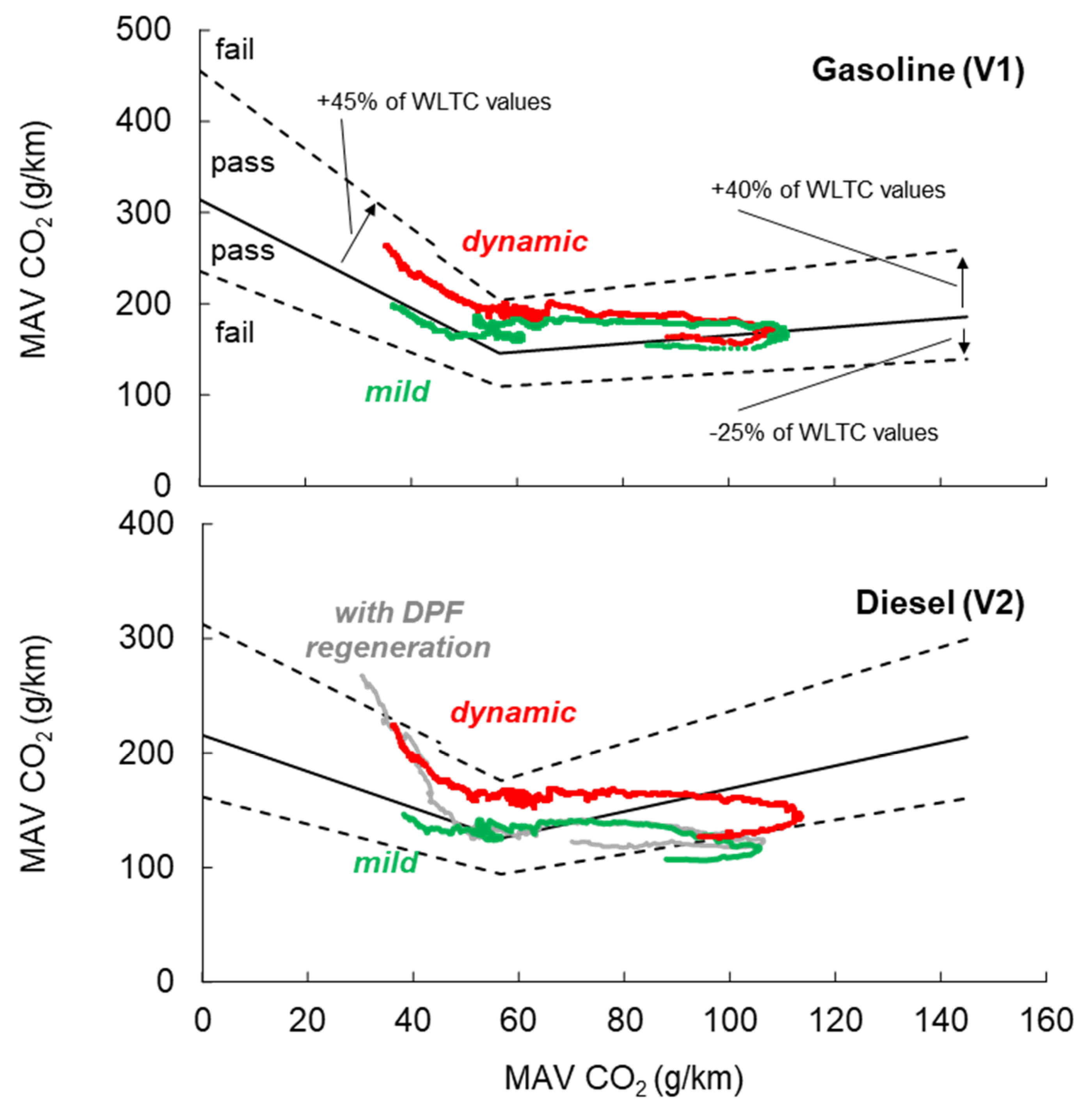

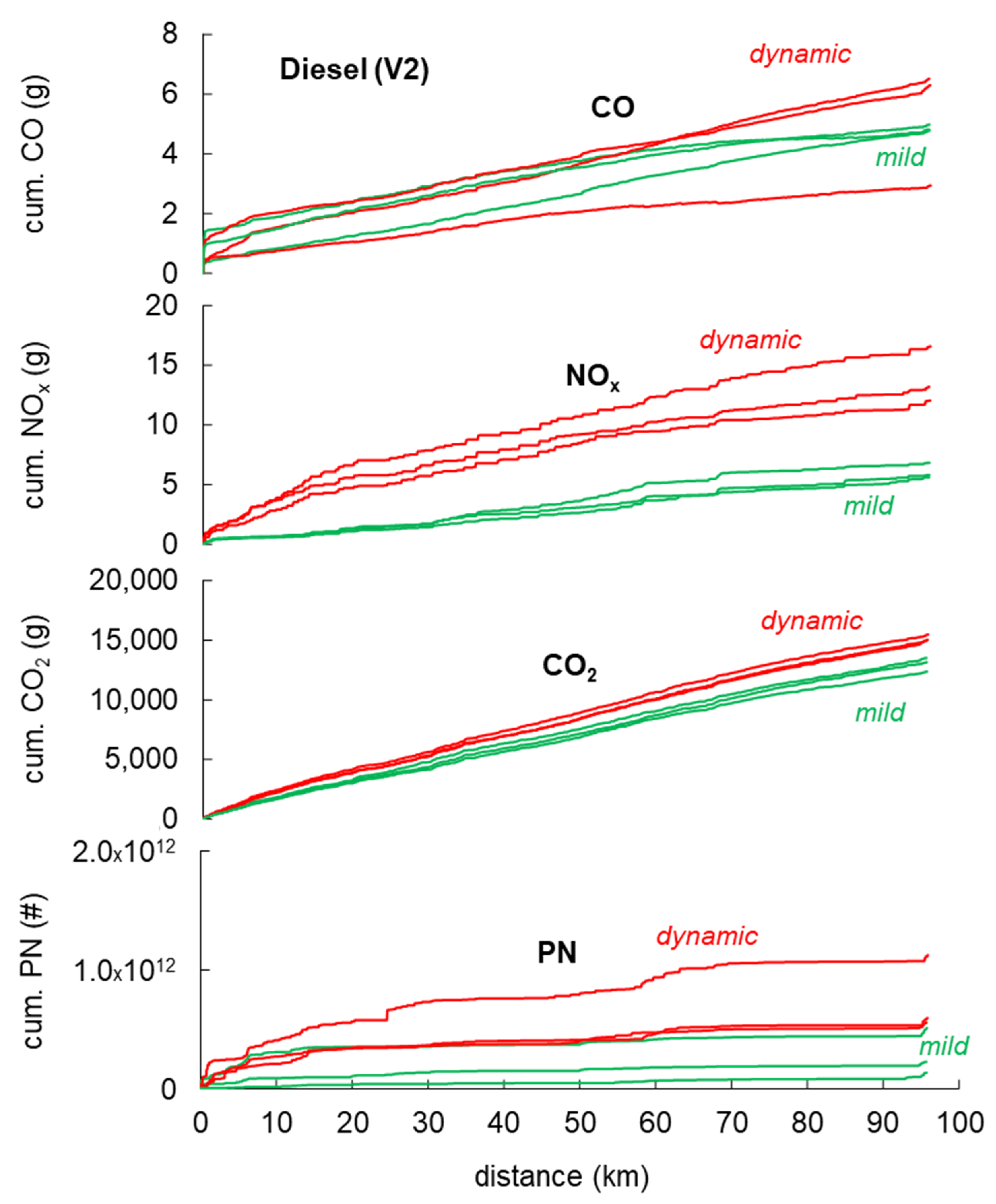


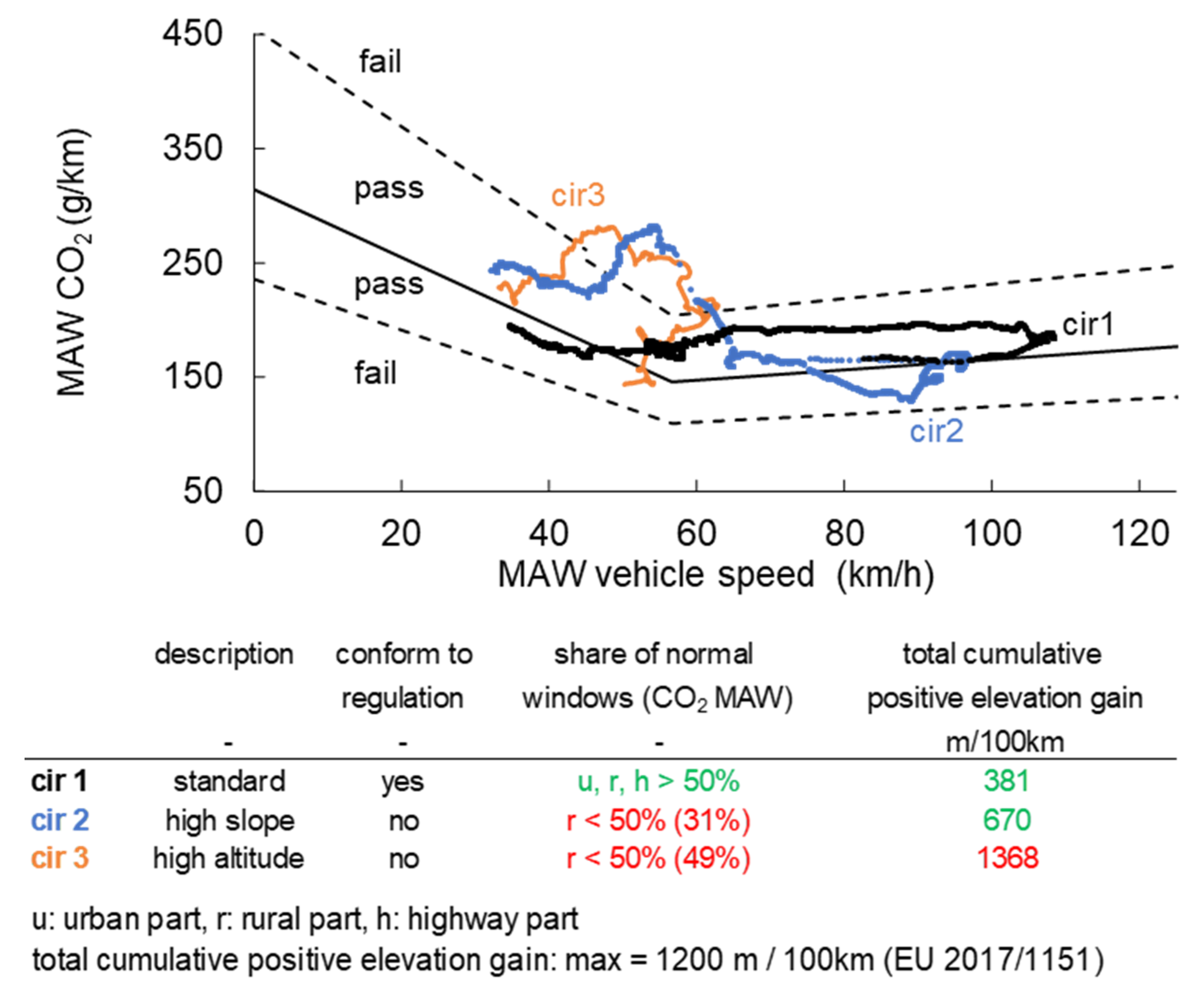
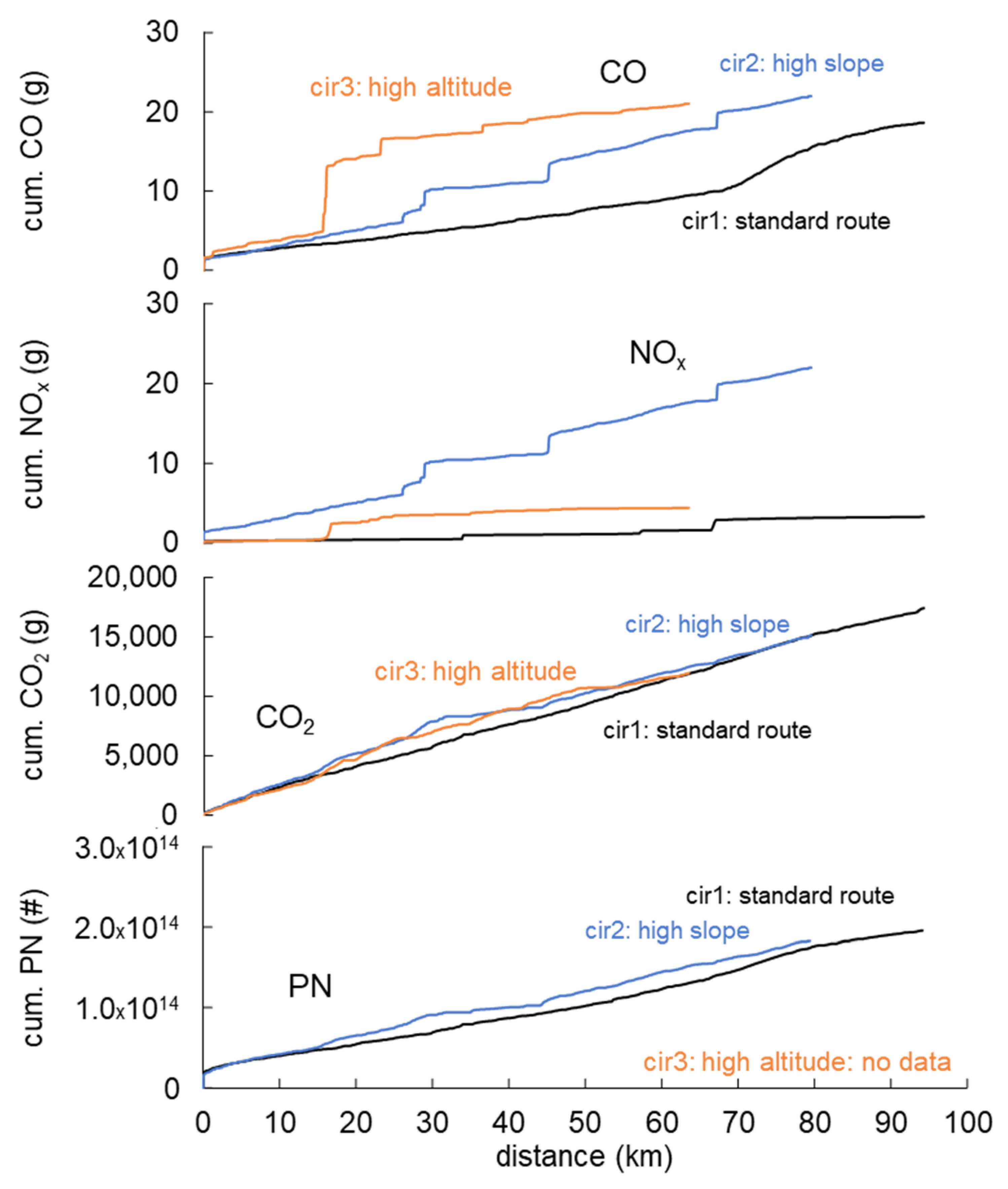
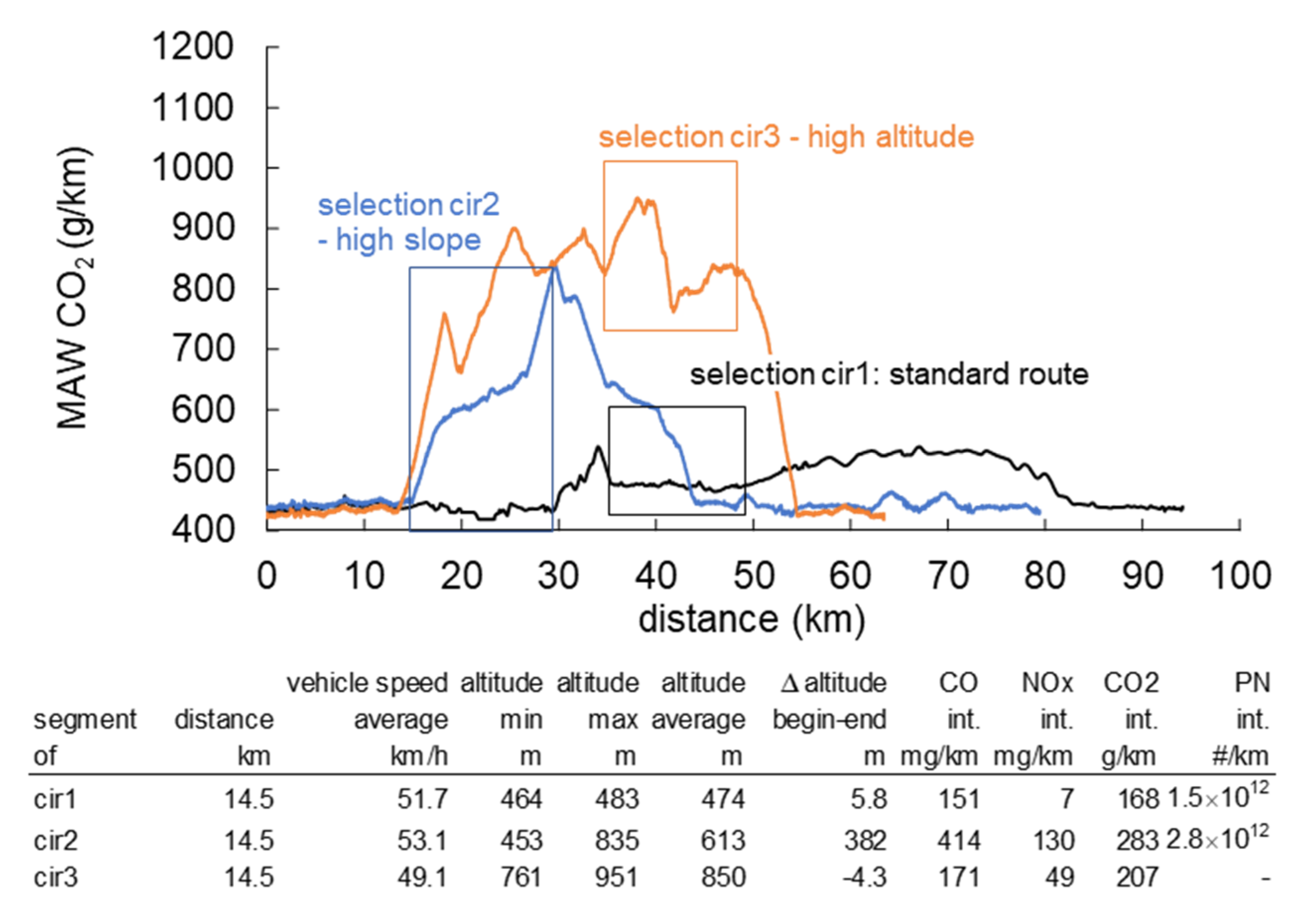
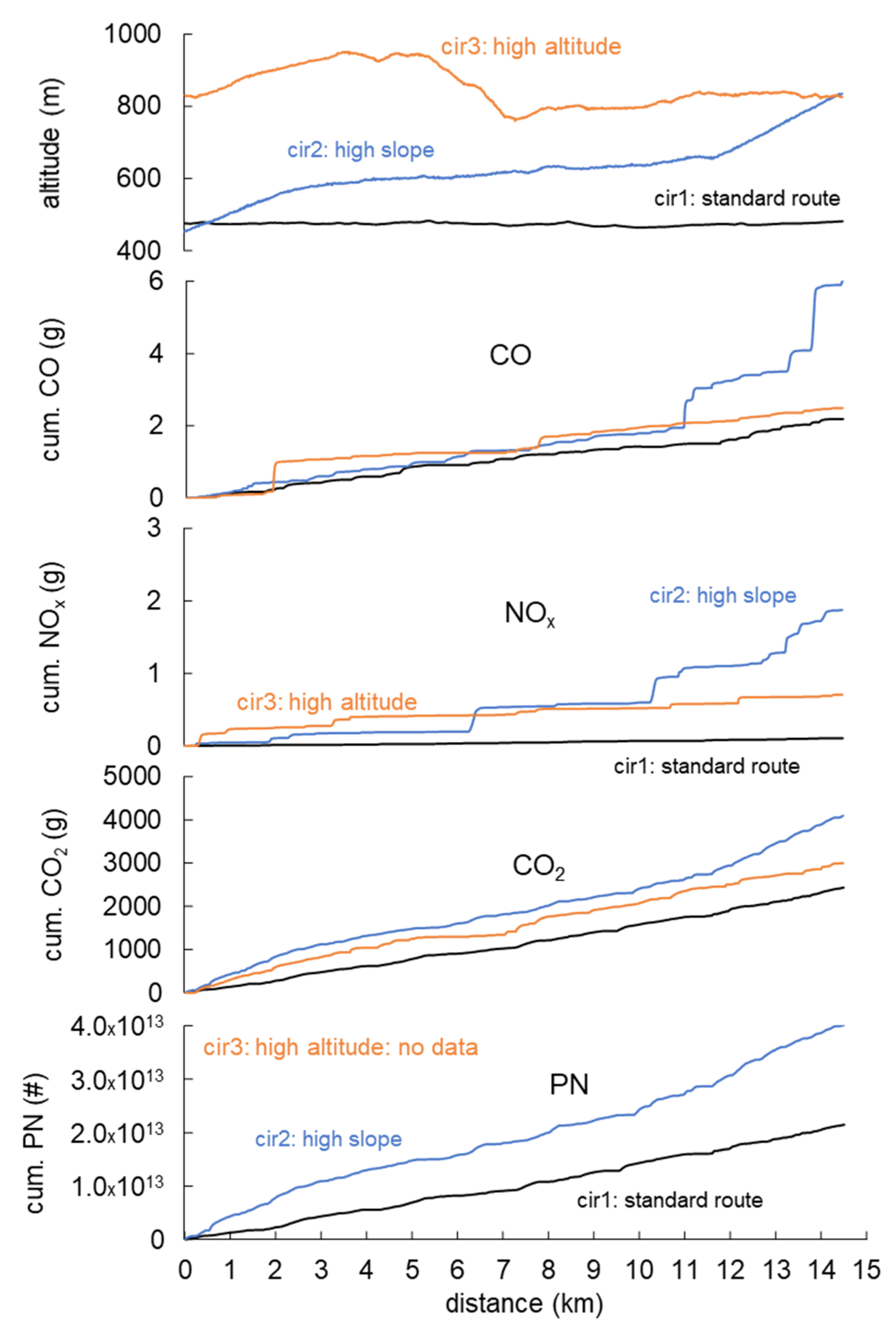
| Name | Type | Model | Fuel | EATS | Displ. | Power | ||
|---|---|---|---|---|---|---|---|---|
| - | - | Year | - | - | - | ccm | kW | |
| V1 | LDV | PC | 2012 | Gasoline | Euro 5a | 3WC | 1.596 | 132 |
| V2 | LDV | PC | 2017 | Diesel | Euro 6b | DPF + SCR | 1.968 | 110 |
| Gas PEMS | |
|---|---|
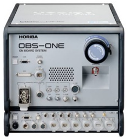 | |
| Instruments | Horiba PEMS OBS-ONE |
| Exhaust concentrations | CO2, CO, NOx, NO2,THC |
| Measurement principle | heated NDIR *, CLD, heated line |
| Engine parameters | OBD |
| Vehicle speed and position | GPS |
| Exhaust flow | EFM |
| Ambient parameters | p, T, H |
| Electrical power | >300 W (>800 W with FID and PN) |
| Dimensions | 500 × 500 × 500 mm +Pitot tube +heated line +batteries |
Publisher’s Note: MDPI stays neutral with regard to jurisdictional claims in published maps and institutional affiliations. |
© 2021 by the authors. Licensee MDPI, Basel, Switzerland. This article is an open access article distributed under the terms and conditions of the Creative Commons Attribution (CC BY) license (https://creativecommons.org/licenses/by/4.0/).
Share and Cite
Engelmann, D.; Zimmerli, Y.; Czerwinski, J.; Bonsack, P. Real Driving Emissions in Extended Driving Conditions. Energies 2021, 14, 7310. https://doi.org/10.3390/en14217310
Engelmann D, Zimmerli Y, Czerwinski J, Bonsack P. Real Driving Emissions in Extended Driving Conditions. Energies. 2021; 14(21):7310. https://doi.org/10.3390/en14217310
Chicago/Turabian StyleEngelmann, Danilo, Yan Zimmerli, Jan Czerwinski, and Peter Bonsack. 2021. "Real Driving Emissions in Extended Driving Conditions" Energies 14, no. 21: 7310. https://doi.org/10.3390/en14217310





